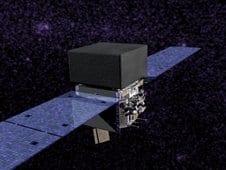
The Fermi space telescope
By Hamish Johnston
“…2009 promises to be an illuminating year for dark matter”.
So wrote this sage of physics, just before Christmas.
It turns out that my crystal ball got one thing right — we will learn something important about dark matter this year, and that is we are going to have to look even harder for direct evidence of the elusive stuff.
Two papers published earlier this week provide pretty convincing evidence that ‘direct evidence’ is not going to be forthcoming from current measurements of how many high-energy electrons and positrons are whizzing around our little patch of the universe. One paper is from the Fermi telescope group and the other is from the HESS collaboration.
The papers offer strong evidence that these fluxes can be explained without the need of dark matter — and in particular the annihilation of dark-matter particles in the halo of our galaxy.
The excitement began last summer when ‘physics paparazzi’ photographed a slide of data from the PAMELA detector showing what appeared to be an excess of high-energy positrons. This lead to a flurry of activity as some physicists analysed the unpublished results and pointed to DM annihilation.
Then in November physicists working on the ATIC experiment published results suggesting an excess of high-energy electrons — which they suggested could come from DM annihilation.
However, a few weeks earlier the PAMELA team posted a paper that should have dampened my spirits — but I foolishly ignored it, something that at least one reader has since pointed out to me.
PAMELA should have also seen a bump in the ratio of anti-protons/protons in the cosmic ray flux caused by dark matter annihilating to create anti-protons. But the bump wasn’t there.
Now, data from two new detectors — Fermi and HESS — have been analysed and there seems to be no evidence of dark matter annihilation.
If you are interested in the nitty gritty, Tommas Dorigo has a data-point-by-data-point commentary on data from both detectors on his blog.



